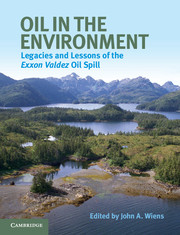Book contents
- Frontmatter
- Contents
- List of contributors
- Use of acronyms
- Acknowledgments
- A bibliographic note
- Prologue
- Part I Introduction and background
- Part II Oil in the environment
- Part III Biological effects
- 9 Cytochrome P450 1A (CYP1A) as a biomarker in oil spill assessments
- 10 Assessing effects and recovery from environmental accidents
- 11 Shoreline biota
- 12 Oiling effects on pink salmon
- 13 Pacific herring
- 14 Oil and marine birds in a variable environment
- 15 Sea otters: trying to see the forest for the trees since the Exxon Valdez
- Part IV Assessing oil spill effects and ecological recovery
- Part V Conclusions
- Index
- References
10 - Assessing effects and recovery from environmental accidents
Published online by Cambridge University Press: 05 July 2013
- Frontmatter
- Contents
- List of contributors
- Use of acronyms
- Acknowledgments
- A bibliographic note
- Prologue
- Part I Introduction and background
- Part II Oil in the environment
- Part III Biological effects
- 9 Cytochrome P450 1A (CYP1A) as a biomarker in oil spill assessments
- 10 Assessing effects and recovery from environmental accidents
- 11 Shoreline biota
- 12 Oiling effects on pink salmon
- 13 Pacific herring
- 14 Oil and marine birds in a variable environment
- 15 Sea otters: trying to see the forest for the trees since the Exxon Valdez
- Part IV Assessing oil spill effects and ecological recovery
- Part V Conclusions
- Index
- References
Summary
Introduction
When an environmental accident such as an oil spill occurs, several things happen. There can be immediate efforts to contain the damage to natural ecosystems or human structures or livelihoods. Steps can be taken to provide relief to the people or environments most immediately affected. If the accident is sufficiently large, media accounts can fuel responses by the broader public. For damages resulting from human-caused accidents, claims and counter-claims of the magnitude and extent of the accident and its consequences will be made and then amplified, often followed (in the United States, at least) by litigation. All of these consequences require knowledge of what really happened – where did the oil go, what natural resources or services were affected, and how persistent were these effects? As the chapters in this book amply demonstrate, the need for careful, rigorous, and objective science is paramount.
Just because there is a need for careful, rigorous, and objective science, however, does not mean that it is easily attainable. Because of demands for immediate action and the heightened emotions following an environmental accident, attempts to document the ecological effects and subsequent recovery run the risk of being hastily developed and inadequately designed. This can foster never-ending arguments about conclusions. Such accidents occur against a complex and dynamically varying environmental background, so they cannot be treated as traditional experiments to be analyzed with straightforward statistical procedures that are planned in advance. There is only a single replicate of the “treatment” (i.e., the accident), there are no pre-established controls, and a welter of other factors with varying degrees of intercorrelation confounds attempts to attribute observed changes to the environmental accident. After all, the real world is messy! Designing field studies and analyses that are quantitative, objective, and scientifically rigorous under such circumstances is difficult – yet it is essential.
- Type
- Chapter
- Information
- Oil in the EnvironmentLegacies and Lessons of the Exxon Valdez Oil Spill, pp. 220 - 240Publisher: Cambridge University PressPrint publication year: 2013
References
- 1
- Cited by



